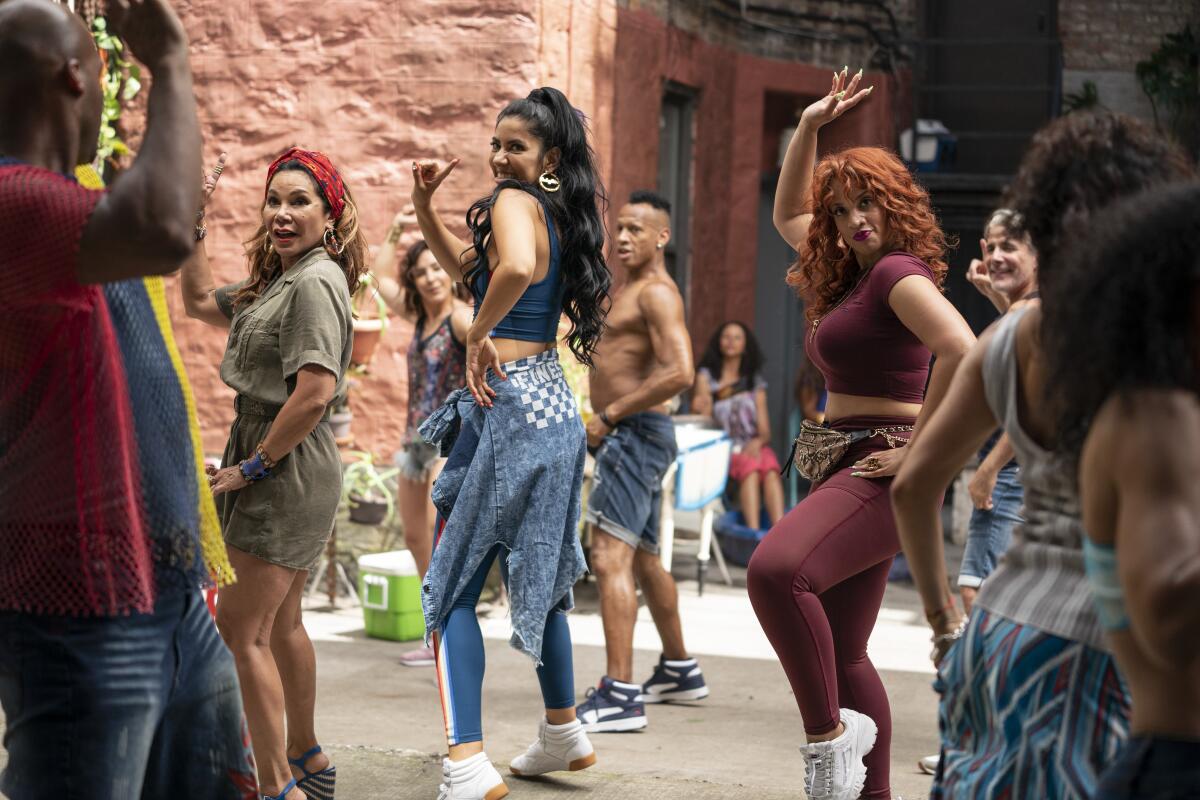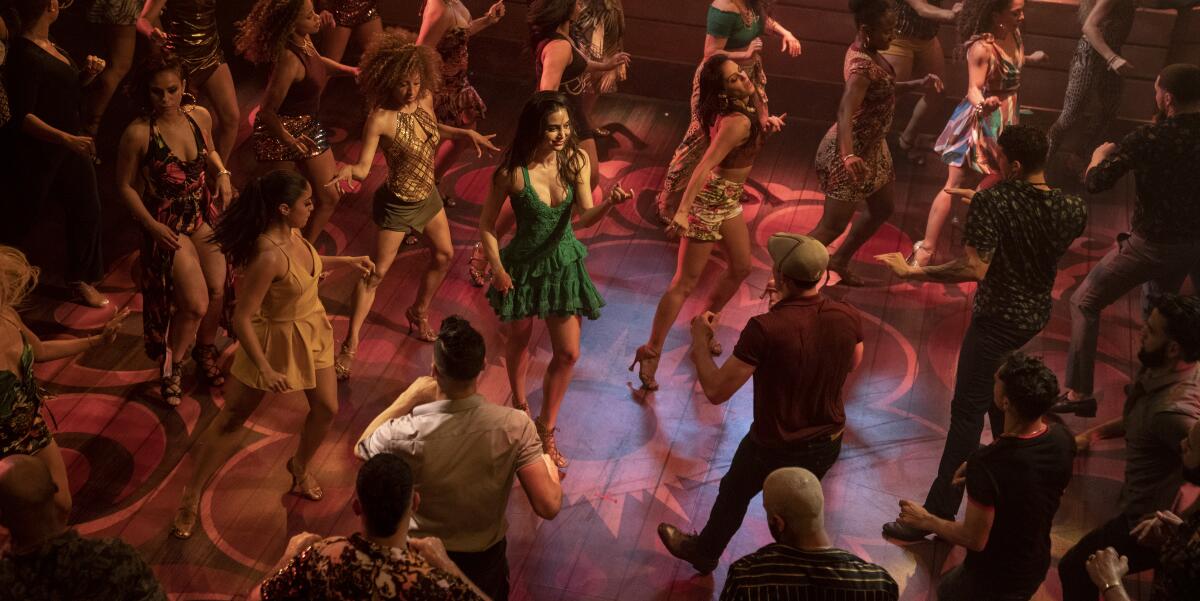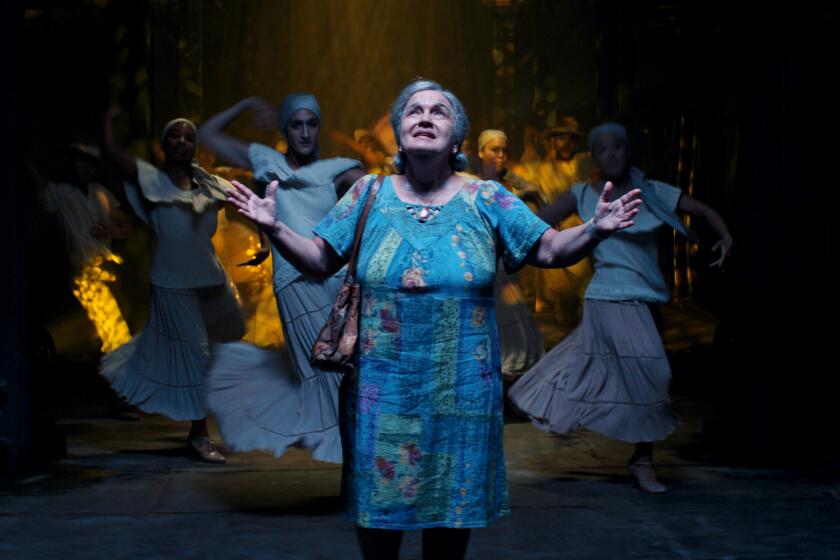Commentary: How Hollywood’s box-office ‘parlor game’ hurts movies like ‘In the Heights’

Depending on the source, the opening weekend of “In the Heights” was “muted” and “modest,” “disappointing,” even “dismal.” Whatever the words used to describe it, though, the film’s initial box office haul was the same: In its first few days of nationwide screenings, it earned $11.4 million in ticket sales, short of the expected $15 million to $20 million.
Numbers, of course, are only part of the story. In a pop culture landscape dominated by sequels, reboots and cinematic universes — whose power stems in part from the surefire receipts — the conversation around box office has become “do or die” for the increasingly small set of major studio movies that fall outside the franchise category, particularly those centered on underrepresented audiences.
“In the Heights” is simply the latest and highest-profile example of Hollywood’s “proof of concept” problem: By unfairly demanding these films justify not only their own existence but also that of any similar project to follow, the discourse with which industry experts saddle such pictures may be perpetuating Hollywood’s intractable diversity problems rather than fixing them.
What do these numbers even mean? Box-office expectations for the Warner Bros. movie-musical were determined in part by tracking, a data-based process in which a research firm is hired by a studio to measure the potency of its movie’s marketing efforts. That’s done by frequently surveying a representative sample of filmgoers — hundreds of people who vary in age, gender, cultural background and place of residence — about their awareness, interests and choices around future releases.
Who decided “In the Heights” was supposed to be the Latino “Crazy Rich Asians”?
According to a source at one tracking firm, a person’s ability to independently recall an upcoming title is the strongest indicator of its box-office potential. (Still, there are exceptions: Tracking survey respondents were plenty aware of “Cats” but did not watch it.)
The firm considers this data — along with the movie’s genre, star power, scores on review aggregation sites, screen count, release date, social media buzz, simultaneous opening titles and “comps” (opening-weekend grosses of comparable movies in the past) — to calculate the expected range for the film’s opening box office take. Though these totals are not perfect calculations, they remain valuable internal tools for studios which, in the crucial weeks before a release, can make necessary adjustments to their marketing spends and strategies.

The problem arises when these private approximations become public, often as a distributor tries to temper expectations to produce an “overperformance” narrative (See also: political debates) or a competitor tries to shake up a film’s rollout with a negative headline.
“The main reason tracking exists is to measure the efficacy of your advertising campaign,” says Kevin Goetz, founder and chief executive of Screen Engine/ASI, a market research and data analytics firm. “But unfortunately, many people within the industry, and the press, have turned it into a parlor game.”
Opening weekend numbers are more than something to crow about (or downplay) in the media. They’re used to set the price for even the most far-off ancillary deals, such as the film’s TV airing in an international territory years after its U.S. theatrical release, said one executive.
Lin-Manuel Miranda and Jon M. Chu’s ‘In the Heights’ has an impressive cast, but little Afro-Latinx or LGBTQ+ representation. Now Miranda has apologized.
The grosses generally indicate how it’ll perform throughout the rest of its theatrical run. (There are exceptions, of course, such as “The Greatest Showman,” which went on to $480 million worldwide after a poor opening.) And if a movie is playing particularly well in a certain part of the country, it’ll spur additional screens and showings in that region’s theaters.
Then there are the qualitative consequences: A positive headline about an opening can reverberate throughout the industry, leading previously untested writers and directors to secure their next projects; breakout stars, along with their agents and managers, to gain leverage in negotiating deals; projects similar to the newly crowned hit to receive the elusive green light. Female action vehicles drew a buzz after the strong opening of “Wonder Woman,” for instance, and Asian-led narratives gained steam after crowds came out for “Crazy Rich Asians.”
“What gets the industry’s attention?” says box-office analyst Karie Bible of Exhibitor Relations. “Good reviews? Maybe. Buzz on the internet? Could help. Money? You bet. Hollywood pays attention to one color, and that’s green.”

Especially when it comes to high-budget studio films with nonwhite casts, however, opening weekend box office is an unnecessarily blunt instrument. The historical scarcity of such movies, thanks to Hollywood’s own well-documented diversity failures, means they are taken as a barometer of the audience for similar future projects — a level of pressure rarely if ever applied to an equivalent film with a white director, writer and cast. As The Times’ Ryan Faughnder writes, “One byproduct of the industry’s shortcomings with inclusion is that any studio movie depicting an underrepresented group in a culturally specific way becomes a potential watershed moment.”
It’s not to overlook “In the Heights’” real flaws — namely, its failure to represent Washington Heights’ Afro-Latinx community, which has now spurred several news cycles of criticism and apology — to suggest that the industry’s demand for “proof of concept” is holding it back from innovation: After all, filmmaking that has no room for error at the box office is unlikely, in the long run, to be terribly interesting filmmaking.
Lin-Manuel Miranda, Jon M. Chu, Olga Merediz and others break down ‘Paciencia y Fe,’ the immigrant ballet sure to give viewers a ‘big gasp moment.’
And that’s to say nothing of the ruthlessness of a system in which, after years of development, weeks of shooting and months of marketing, the fate of a movie, and those that come after it, hangs on just a few days. As one Golden Age screenwriter character asks in the movie “The Holiday,” released in 2006: “A picture has to make a killing the first weekend or they’re dead. This is supposed to be conducive to great work?”
That this conversation arises again and again, at fever pitch, around the vanishingly rare major studio movies with nonwhite leads, only underscores the problem. At an uncertain juncture for the industry, one in which moviegoing patterns have been upended by a pandemic and, well before that, the advent of streaming platforms, the parlor game’s fundamental lack of imagination should be seen as worrisome — because it is. If the industry is going to follow through on its promises to become more inclusive, it will have to learn to define the “success” of a film more broadly than dollars and cents. And preferably on that film’s own merits.
More to Read
Only good movies
Get the Indie Focus newsletter, Mark Olsen's weekly guide to the world of cinema.
You may occasionally receive promotional content from the Los Angeles Times.










